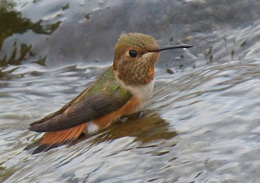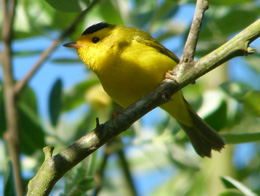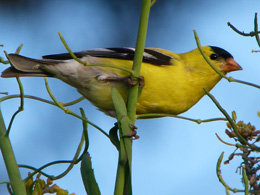 July
July
The Anna’s Hummingbirds have re-established themselves at El Polin Spring, a tranquil oasis in the heart of the Presidio. The Allen’s Hummingbirds have left, giving the spring back to the Anna’s. There are two species of hummingbirds that are commonly found in San Francisco. The four inch Anna’s are found here all year round, and most of the time, if you see a hummingbird, it’s an Anna’s (there’s one preening on a branch in my back yard as I write this). Anna’s are mostly green and gray, but the male has a bright red throat and crown that looks iridescent in the right light.
The Allen’s Hummingbird, visibly smaller than the Anna’s, are migratory. They spend their summers here. Of course, they have a different definition of summer than we do. They are one of the first migrants to show up in San Francisco, arriving in what we would consider to be the heart of winter, in mid-February. But then again, they are also the first migrants to leave. In the middle of June, I observed 14 hyper active Allen’s Hummingbirds zooming around El Polin Spring.  As of last weekend, there were none left, and Anna’s Hummingbirds had taken their place at the spring (although in much smaller numbers). These green and orange hummingbirds, although smaller than the Anna’s, are much more aggressive, and chase away the larger Anna’s from any desired site.
As of last weekend, there were none left, and Anna’s Hummingbirds had taken their place at the spring (although in much smaller numbers). These green and orange hummingbirds, although smaller than the Anna’s, are much more aggressive, and chase away the larger Anna’s from any desired site.
El Polin Spring, by the way, was the source of fresh water for Spanish and Mexican settlers who made their new home in the Presidio in the 19th Century. Today it is a picnic area in the Tennessee Hollow Watershed, and is one of the best places to see birds in San Francisco, particularly small birds who bathe in its waters every day. Unlike birding elsewhere in the City, here you can stand in one spot and watch birds come to you.

 Some of the commonly seen birds at the spring in the summer include Wilson’s Warbler, a bright yellow bird with a black cap; American and Lesser Goldfinches; Pine Siskins; Chestnut-Backed Chickadees; House and Purple Finches; and Dark-Eyed Juncos. It’s also a place where birds raise their young. Last month every tree in the area seemed to have holes with Pygmy Nuthatches zooming in and out to feed their chicks; baby Robins hopped around the grass in the center of picnic area; and it was possible to hear young Hairy Woodpeckers calling out for their parents to deliver food to their nest hole in a tree a few yards up the trail from the spring.
Some of the commonly seen birds at the spring in the summer include Wilson’s Warbler, a bright yellow bird with a black cap; American and Lesser Goldfinches; Pine Siskins; Chestnut-Backed Chickadees; House and Purple Finches; and Dark-Eyed Juncos. It’s also a place where birds raise their young. Last month every tree in the area seemed to have holes with Pygmy Nuthatches zooming in and out to feed their chicks; baby Robins hopped around the grass in the center of picnic area; and it was possible to hear young Hairy Woodpeckers calling out for their parents to deliver food to their nest hole in a tree a few yards up the trail from the spring.
© Photos by David Assmann
Bird List
Anna’s Hummingbirds
Allen’s Hummingbird
American and Lesser Goldfinches
Pine Siskins
Chestnut-Backed Chickadees
House and Purple Finches
Dark-Eyed Juncos
Pygmy Nuthatches
Robins
Hairy Woodpeckers